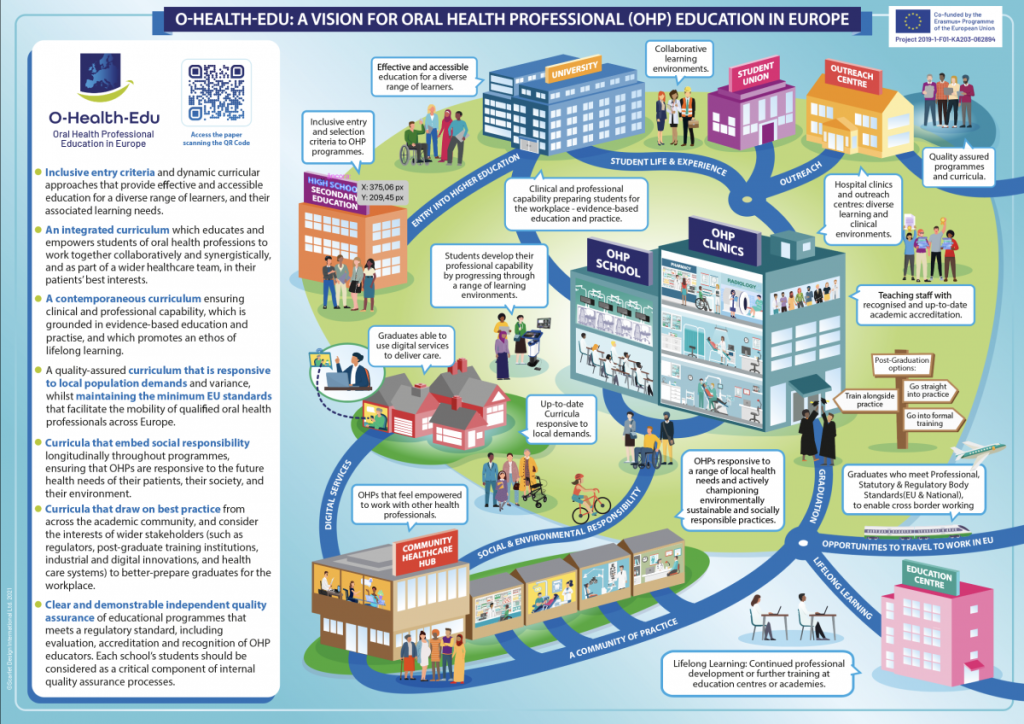A 3-point answer (translation of an article originally published in French on 14 February 2024).
Last autumn researchers involved in a major European project (J.Dixon and colleagues, including S.Tubert-Jeannin, V.Roger-Leroi & S. Vital) published a survey on the training of dentists in Europe (1,2). The survey is available online and is entitled « O-HEALTH-EDU: A viewpoint into the current state of Oral Health Professional education in Europe »(available on-line : part 1, part 2).
Professor Tubert-Jeannin (Department of Oral Public Health, University of Clermont Auvergne, France), who is coordinating the project, explains the significance of this study.
1 What are the main conclusions of your study, the most recent of its kind in Europe?
There are three.
Firstly, we can go beyond preconceived ideas:
This survey, which covers the period 2019-2023, gathers objective, up-to-date and readable data on the training of oral health professionals in Europe.
To my knowledge, this is the first time that such a complete picture has been drawn up of the current state of training in Europe, not only for dentists but also for other oral health professionals.
Secondly, we can highlight the existing dynamic:
The survey shows that universities are committed to modernising the training of oral health professionals. For example, 20% of respondents say that they base their training programme on an integrated approach, preparing the students to acquire the professional skills that are expected on day-one.
We were also pleased to discover that 35% of faculties have introduced future professionals to research, and that 45% have set up activities to develop inter-professional relations, whether within the dental practice or with other health professions.
Thirdly, we can state the diversity of training practices:
The universities’ autonomy inevitably leads to variations of training both at national and European levels. We talk about almost 200 dental schools. These differences relate, for example, to the recruitment method, the opportunities for international exchanges during studies, and the year from which the student starts clinical activity.
What struck us when reading these data is that those undeniable variations are underpinned by a strong adherence (60%) to the guidelines of The Graduating European Dentist, which is a very precise European framework developed by the ADEE (Association for Dental Education in Europe) to establish the most comprehensive initial training programme.
2 What obstacles did you have to overcome to carry out your study?
We can list at least two, which are common when it comes to conducting a Europe-wide survey.
The first difficulty was language.
Oscar Wilde said the main difference between England and the United States is language. In a region where more than twenty languages co-exist, we had to overcome the differences in definitions and in understanding by drafting a common educational glossary(3) that would be accepted and understandable by everyone. This has been one of the major achievements of the O-Health-Edu project, which also includes other aspects such as the publication of a vision for the future of education in Europe(4).

The second difficulty is the number of respondents
The response rate to a survey is a major quality factor. In the future, of course, we would like to see the number of respondents increase so that we have a complete map of training courses. This map is available on the O-Health-Edu website.
3 What’s next for O-Health-Edu?
The survey is part of a vast partnership project set on a European scale. It was funded by the Erasmus programme for the period 2019 to 2023, and was fully completed last year. Now it is the ADEE, which FEDCAR knows well, which will take over. The aim will be to use the infrastructure put in place by the survey to continue collecting data.
Our survey is not a one-shot exercise intended to be archived and never repeated. On the contrary, this database will be updated in order to provide input for decisions taken by the public authorities and for academic discussions on the training of oral health professionals.
***
- Dixon J, Field J, Vital S, van Harten M, Roger-Leroi V, Davies J, Manzanares-Cespedes MC, Akota I, Murphy D, Paganelli C, Gerber G, Quinn B, Tubert-Jeannin S. O-HEALTH-EDU: A viewpoint into the current state of Oral Health Professional education in Europe: Part 1: Programme-level data. Eur J Dent Educ. 2024 Jan 8. doi: 10.1111/eje.12989. Epub ahead of print. PMID: 38186364.
- Dixon J, Tubert-Jeannin S, Davies J, van Harten M, Roger-Leroi V, Vital S, Paganelli C, Akota I, Manzanares-Cespedes MC, Murphy D, Gerber G, Quinn B, Field J. O-Health-Edu: A viewpoint into the current state of oral health professional education in Europe: Part 2: Curriculum structure, facilities, staffing and quality assurance. Eur J Dent Educ. 2024 Jan 22. doi: 10.1111/eje.12987. Epub ahead of print. PMID: 38258340.
- Davies JR, Field J, Dixon J, Manzanares-Cespedes MC, Vital S, Paganelli C, Akota I, Quinn B, Roger-Leroi V, Murphy D, Gerber G, Tubert-Jeannin S. ARTICULATE: A European glossary of terms used in oral health professional education. Eur J Dent Educ. 2023 May;27(2):209-222. doi: 10.1111/eje.12794. Epub 2022 Mar 8. PMID: 35224823.
- Field J, Dixon J, Davies J, Quinn B, Murphy D, Vital S, Paganelli C, Akota I, Gerber G, Roger-Leroi V, Manzanares-Cespedes MC, Tubert-Jeannin S. O-Health-Edu: A vision for oral health professional education in Europe. Eur J Dent Educ. 2023 May;27(2):382-387.
